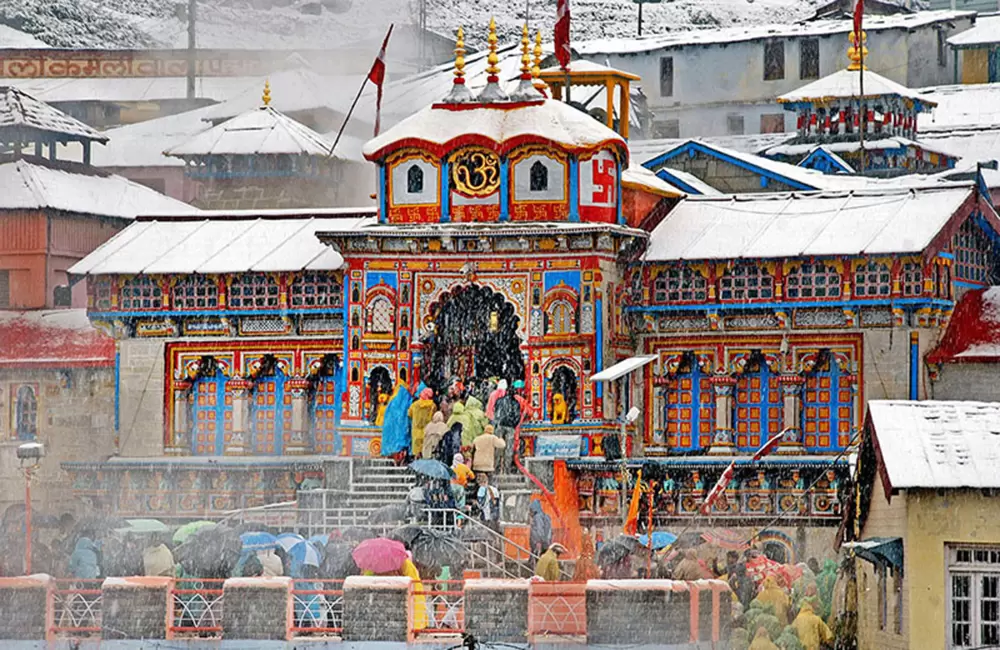
3 Days Badrinath Package From Haridwar
What's included?
Tour Itinerary
Day 1Haridwar - Badrinath (320kms/10hr) Height: 3133 MTS.
The morning after breakfast, drive to Badrinath (06:00 Am). Check in to the hotels in Badrinath. Pilgrims after having a bath in the Taptkund have the Darshan of Badrivishal & Aarti in the evening. Brahamakapal is significant for Pinddan Shraddh of ancestors (Pitrus). There are other interesting sightseeing spots like Mana village, Vyas Gufa, Mata murti, Charanpaduka, Bhimkund and the "Mukh" of the Saraswati River. Just within the three kms of Badrinathjee. Overnight stay at Badrinath.
Badrinath one of the 'Ancient Four Dhams' is one of the most celebrated pilgrimage spots of the country and is situated at an elevation of 3,133 meters, guarded on either side by the two mountain ranges known as Nar & Narayan with the towering Neelkanth Peak providing a splendid backdrop. This revered spot was once carpeted with wild berries. Thus the place got the name "Badri van", meaning "forest of berries".
Tapt Kund: Natural thermal springs on the bank of the river Alaknanda, where it is customary to bathe before entering the Badrinath temple.
Mana Village: Inhabited by an Indo-Mongolian tribe, it is the last Indian village before Tibet.
Vasundhara: As the name suggests, Vasundhara fall is a magnificent waterfall. This place is 5 kms. from Badrinath out of which 2 kms. is motorable up to Mana.
Bhim Pul: On the other side of Mana village, a massive rock forming a natural bridge, lies over the roaring Saraswati river. It presents a spectacular view of water thundering down through the narrow passage under the rock and is believed to have been placed there by Bhim, the second eldest among the five Pandava brothers.
Vyas Gufa (cave): Near Mana Village, this is a rock-cave where Ved Vyas is believed to have composed the Mahabharata and the pauranic commentaries.
Badrinath Weather: The average maximum temperature will be around 18° Celsius and the average minimum is 8° Celsius. Warm and woolen clothes are hence required for a stay in Badrinath throughout the year. Winter in Badrinath is often accompanied by snowfalls. Winter is very chilly with an average temperature of 5° Celsius. Due to the extreme climatic conditions, this time is usually closed for tourists.
Day 2Badrinath - Joshimath - Rudraprayag (160kms/7hr) Height: 895 MTS.
The morning after breakfast, the driver for Rudraprayag via Joshimath. Visit on the way Narsingh Temple in Joshimath later drive back to Rudraprayag via Joshimath. Check into the hotel's arrival in Rudraprayag. Overnight stay at Rudraprayag.
Joshimath is situated on the slopes above the confluence of the rivers Alaknanda and Dhauliganga. Of the four 'Maths' established by Adi Shankaracharya, Joshimath is the winter seat of Badrinath. The idol is brought down to Joshimath and installed in the temple for people to worship. There are many other temples in the township. The most important is the temple of Nir Singh with the idol of Lord Vishnu. The left arm of this deity is getting destroyed with time and the popular belief holds that the day the arm completely withers Badrinath valley will cease to exist and the Gods will transfer the residence into the neighboring Niti Valley at Bhavishya Badri.
Rudraprayag is one of the Panch Prayag (five confluences) of the Alaknanda River. It is the confluence of rivers Alaknanda and Mandakini. Kedarnath, a Hindu holy town is located 86 km from Rudraprayag.
Rudraprayag Weather - Generally hot in summer, the temperature ranges from 35-40 degrees Celsius, Winter: The Days are pleasantly cool but the nights are cold, temp ranges from 20 deg to 05 deg.
Day 3Rudraprayag - Haridwar (165kms / 5-6hr)
The morning after breakfast, drive for Haridwar via Rishikesh. Rishikesh 'place of sages' is a celebrated spiritual town on the bank of Ganga and is surrounded by Shivalik range of the Himalayas on three sides. It is said that when Raibhya Rishi did hard penances, God appeared by the name of " Hrishikesh " and this area hence firth came to be known as Rishikesh. Check-in to the hotel in Rishikesh. Later visit Rishikesh Temples & Sight Seeing – Laxman Jhula, Ram Jhula. Drop at Haridwar.
Rishikesh: Named after the Lord Vishnu, Rishikesh is a holy city for Hindus. Located in the foothills of the Himalaya in northern India it is also known as the yoga center of the world and is home to many world-renowned ashrams. Rishikesh styles itself as the ‘Yoga Capital of the World’, with masses of ashrams and all kinds of yoga and meditation classes. The fast-flowing Ganges is surrounded by forested hills inside the city. Apart from temples and ashrams, Rishikesh is now a popular white-water rafting center, backpacker hang-out, and gateway to treks in the Himalaya.
Customize this Tour 3 Days Badrinath Package From Haridwar
Reach out to us to customize this tour package as per your requirments, group size, transport upgrade, hotel upgrade and modify inclusions or exclusions.Package Inclusions
- Hotel accommodation as per package same or similar hotels.
- Breakfast + Dinner.
- Transfers and sightseeing as prepackage car.
- All toll tax, parking, fuel and driver allowances.
- All applicable hotel and transport taxes.
Package Exclusions
- GST will be extra.
- Anything not mentioned under ‘Package Inclusions’
- All personal expenses, optional tours and extra meals.
- Medical and travel insurance.
- Any kind of entry fees anywhere if not mentioned in including.
- Tips, travel insurance, medical insurance, laundry charges, liquors, mineral water, telephone charges.
- All items of personal nature.
- Porter, pony, horse, cable car, boat, train tickets, air tickets charges.



